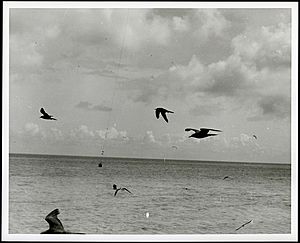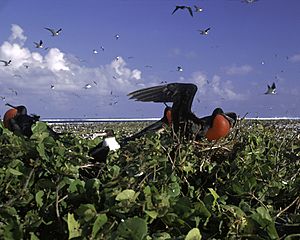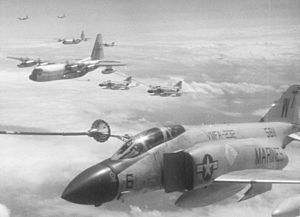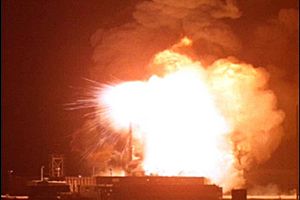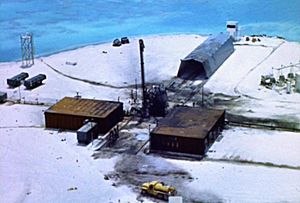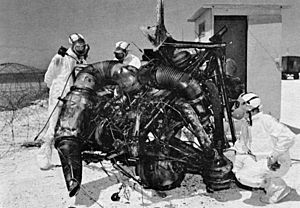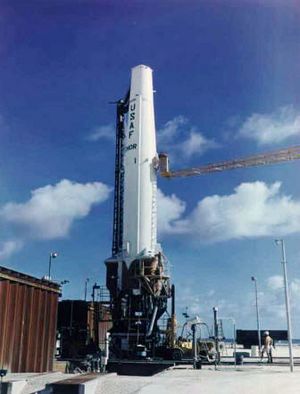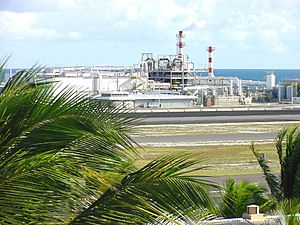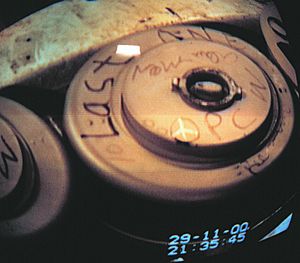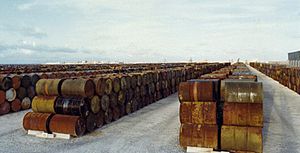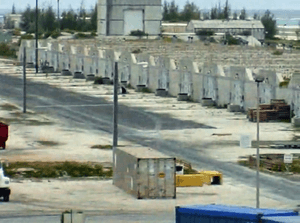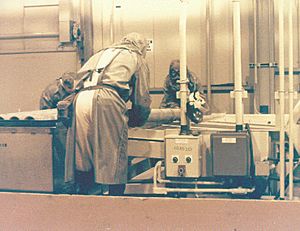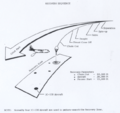Johnston Atoll facts for kids
Quick facts for kids
Johnston Atoll
Kalama Atoll
|
||
|---|---|---|
|
||
| Anthem: "The Star-Spangled Banner" | ||
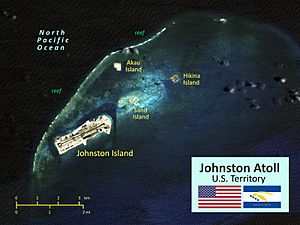
Map of Johnston Atoll
|
||
| Country | United States | |
| Status | unorganized, unincorporated territory | |
| Claimed by U.S. | March 19, 1858 | |
| Government | ||
| • Type | administered as a National Wildlife Refuge | |
| • Body | United States Fish and Wildlife Service | |
Johnston Atoll, also known as Kalama Atoll to Native Hawaiians, is an unincorporated territory of the United States currently administered by the United States Fish and Wildlife Service. Johnston Atoll is a National Wildlife Refuge and is closed to public entry. Limited access for management needs is only by Letter of Authorization from the U.S. Air Force and Special Use Permit from the U.S. Fish and Wildlife Service.
For nearly 70 years, the atoll was under the control of the U.S. military. During that time, it was variously used as a naval refueling depot, an airbase, a nuclear and biological weapons testing site, a secret missile base, and a chemical weapon and Agent Orange storage and disposal site. These activities left the area environmentally contaminated and the reversing of environmental damage and monitoring continue.
Contents
- History
- National Wildlife Refuge since 1926
- Wildlife
- Military control 1934–2004
- National nuclear weapon test site 1958–1963
- Failures
- Biological warfare test site 1965
- Chemical weapon storage 1971–2001
- Agent Orange storage 1972–1977
- Chemical weapon demilitarization mission 1990–2000
- Closure and remaining structures
- Contamination and cleanup
- After closing
- Images for kids
- See also
History
The first Western record of the atoll was on September 2, 1796 when the Boston-based American brig Sally accidentally grounded on a shoal near the islands. The ship's captain, Joseph Pierpont, published his experience in several American newspapers the following year giving an accurate position of Johnston and Sand Island along with part of the reef. However, he did not name or lay claim to the area, which the local tribes referred to as "iwi poʻo mokupuni". The islands were not officially named until Captain Charles J. Johnston of the Royal Naval ship HMS Cornwallis sighted them on December 14, 1807.
The Guano Islands Act, enacted on August 18, 1856, was federal legislation passed by the U.S. Congress that enabled citizens of the U.S. to take possession of islands containing guano deposits. In 1858 William Parker and R. F. Ryan, chartered the schooner Palestine specifically to find Johnston Atoll. They located guano on the atoll in March 1858 and they proceeded to claim the island. By 1858, Johnston Atoll was claimed by both the United States and the Kingdom of Hawaii. In June 1858, Samuel Allen, sailing on the Kalama, tore down the U.S. flag and raised the Hawaiian flag renaming the atoll Kalama. The larger island was renamed Kalama Island, and the nearby smaller island was called Cornwallis.
By 1890 the atoll's guano deposits had been almost entirely depleted (mined out) by U.S. interests operating under the Guano Islands Act. In 1892, HMS Champion made a survey and map of the island, hoping that it might be suitable as a telegraph cable station.
On September 11, 1909, Johnston was leased by the Territory of Hawaii to a private citizen for fifteen years. A board shed was built on the southeast side of the larger island, and a small tramline run up onto the slope of the low hill, to help with the removal of guano. Apparently neither the quantity nor the quality of the guano was sufficient to pay for gathering it so that the project was soon abandoned.
National Wildlife Refuge since 1926
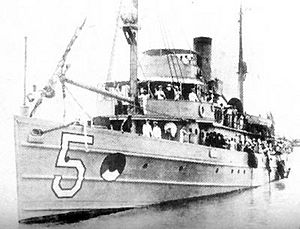
The Tanager Expedition was a joint expedition sponsored by the U.S. Department of Agriculture and the Bishop Museum of Hawaii and visited the Atoll in 1923. The expedition to the atoll consisted of two teams accompanied by destroyer convoys, with the first departing Honolulu on July 7, 1923 aboard the USS Whippoorwill, which conducted the first survey of Johnston Island in the 20th century. Aerial survey and mapping flights over Johnston were conducted with a Douglas DT-2 floatplane.
From July 10–22, 1923, the atoll was recorded in a pioneering aerial photography project. The USS Tanager left Honolulu on July 16 and joined up with the Whippoorwill to complete the survey and then traveled to Wake Island to complete surveys there. Tents were pitched on the southwest beach of fine white sand, and a rather thorough biological survey was made of the island. Hundreds of sea birds, of a dozen kinds, were the principal inhabitants, together with lizards, insects, and hermit crabs. The reefs and shallow water abounded with fish and other marine life.
On June 29, 1926, President Calvin Coolidge established Johnston Island Reservation as a federal bird refuge and placed it under the control of the U.S. Department of Agriculture as a "refuge and breeding ground for native birds." Johnston Atoll was added to the United States National Wildlife Refuge system in 1926, and renamed the Johnston Island National Wildlife Refuge in 1940. The Johnston Atoll National Wildlife Refuge was established to protect the tropical ecosystem and the wildlife that it harbors.
However, the Department of Agriculture had no ships, and the Navy was interested in the Atoll for strategic reasons, so on December 29, 1934, President Franklin D. Roosevelt placed the islands under the "control and jurisdiction of the Secretary of the Navy for administrative purposes," but subject to use as a refuge and breeding ground for native bird.
On February 14, 1941, President Franklin Roosevelt created naval defenses areas in the central Pacific territories. The proclamation established "Johnston Island Naval Defensive Sea Area". "Johnston Island Naval Airspace Reservation" was also established to restrict access to the airspace over the naval defense sea area. Only U.S. government ships and aircraft were permitted to enter the naval defense areas at Johnston unless authorized by the Secretary of the Navy.
In 1990, two full-time U.S. Fish and Wildlife Service personnel, a Refuge Manager and a biologist, were stationed on Johnston Atoll to handle the increase in biological, contaminant, and resource conflict activities.
After the military mission on the island ended in 2004, the Atoll was administered by the Pacific Remote Islands National Wildlife Refuge Complex. The outer islets and water rights were managed cooperatively by the Fish and Wildlife Service with some of the actual Johnston Island land mass remaining under control of the United States Air Force (USAF) for environmental remediation and the Defense Threat Reduction Agency (DTRA) for plutonium cleanup purposes.
However, on January 6, 2009, under authority of the Antiquities Act, The Pacific Remote Islands Marine National Monument was established by President George W. Bush to administer and protect Johnston Island along with six other Pacific islands. The Administration of Barack Obama in 2014 extended the protected area to encompass the entire Exclusive Economic Zone by banning all commercial fishing activities.
Wildlife
About 300 species of fish have been recorded from the reefs and inshore waters of the atoll. It is also visited by green turtles and Hawaiian monk seals. Seabird species recorded as breeding on the atoll include Bulwer's petrel, wedge-tailed shearwater, Christmas shearwater, white-tailed tropicbird, red-tailed tropicbird, brown booby, red-footed booby, masked booby, great frigatebird, spectacled tern, sooty tern, brown noddy, black noddy and white tern. It is visited by migratory shorebirds, including the Pacific golden plover, wandering tattler, bristle-thighed curlew, ruddy turnstone and sanderling. Possibilities of humpback whales using the waters as breeding ground has been suggested albeit in small numbers and irregular occurrences so far. Many other cetaceans possibly migrate through the area, but the species being most notably confirmed is Cuvier's beaked whales.
Military control 1934–2004
On December 29, 1934, President Franklin D. Roosevelt transferred control of Johnston Atoll to the United States Navy under the 14th Naval District, Pearl Harbor, in order to establish an air station. In 1948 the USAF assumed control of the Atoll.
During the Operation Hardtack nuclear test series from April 22 to August 19, 1958 administration of Johnston Atoll was assigned to the Commander of Joint Task Force 7. After the tests were completed, the island reverted to the command of the US Air Force.
From 1963 to 1970 the Navy's Joint Task force 8 and the Atomic Energy Commission (AEC) held joint operational control of the island during high-altitude nuclear testing operations.
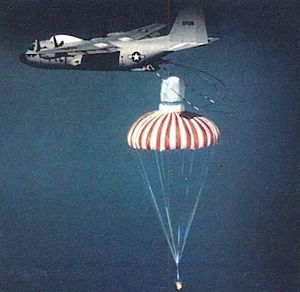
In 1970 Operational control was handed back to the Air Force until July 1973 when Defense Special Weapons Agency was given host-management responsibility by the Secretary of Defense. Over the years different organizations have been the Defense Atomic Support Agency (DASA) from 1959 to 1971, the Defense Nuclear Agency (DNA) from 1971 to 1996, and the Defense Special Weapons Agency (DSWA) from 1996 to 1998.
In 1998, Defense Special Weapons Agency, and selected elements of the Office of Secretary of Defense were combined to form the Defense Threat Reduction Agency (DTRA). In 1999 host-management responsibility transferred from the Defense Threat Reduction Agency once again to the Air Force until the Air Force mission ended in 2004 and the base was closed.
National nuclear weapon test site 1958–1963
Between 1958 and 1975, Johnston Atoll was used as an American national nuclear test site for atmospheric and extremely high-altitude nuclear explosions in outer space. In 1958, Johnston Atoll was the location of the two "Hardtack I" nuclear tests firings. One on 1 August 1958, was codenamed "Hardtack Teak", and one on 12 August 1958 was codenamed "Orange", and both tests detonated 3.8-megaton hydrogen bombs launched to high altitudes by rockets from Johnston Atoll.
Johnston Island was also used as the launch site of 124 sounding rockets going up as high as 1,158 kilometres (720 miles). These carried scientific instruments and telemetry equipment, either in support of the nuclear bomb tests, or in experimental antisatellite technology.
Eight PGM-17 Thor missiles deployed by the U.S. Air Force (USAF), were launched from Johnston Island in 1962 as part of "Operation Fishbowl", a part of "Operation Dominic" nuclear weapons tests in the Pacific. The first launch in "Operation Fishbowl" was a successful research and development launch with no warhead. In the end, "Operation Fishbowl" produced four successful high-altitude detonations: "Starfish Prime", "Checkmate", "Bluegill Triple Prime", and "Kingfish". In addition, it produced one atmospheric nuclear explosion, "Tightrope."
One of these, "Starfish Prime" on July 9, 1962, had a 1.4-megaton explosion, using a W49 warhead at an altitude of about 400 kilometers (250 miles). It created a very brief fireball visible over a wide area, and also bright artificial auroras that were visible for several minutes in Hawaii. "Starfish Prime" also produced an electromagnetic pulse that disrupted some electric power and communication systems in Hawaii. It also pumped enough radiation into the Van Allen belts to destroy or damage seven satellites in orbit.
The final Fishbowl launch that used a Thor missile carried the "Kingfish" 400-kiloton warhead up to its 98-kilometer (61 mi) detonation altitude. "Tightrope" was the final test of Operation Fishbowl and detonated on November 3, 1962. It launched on a nuclear-armed Nike-Hercules missile, and it was detonated at a lower altitude than the other tests:
"At Johnston Island, there was an intense white flash. Even with high-density goggles, the burst was too bright to view, even for a few seconds. A distinct thermal pulse was also felt on the bare skin. A yellow-orange disc was formed, which transformed itself into a purple doughnut. A glowing purple cloud was faintly visible for a few minutes." The nuclear yield was reported in most official documents only as being "less than 20 kilotons". One report by the U.S. Government reported the yield of the "Tightrope" test as 10 kilotons. Seven sounding rockets were launched from Johnston Island in support of the Tightrope test, and this was the final American nuclear atmospheric test.
Failures
The "Fishbowl" series included four failures. The second launch of the Fishbowl series, "Bluegill", carried an active warhead. Bluegill was "lost" by a defective range safety tracking radar and had to be destroyed 10 minutes after lift off. The subsequent nuclear weapon launch failures from Johnston Atoll caused serious contamination to the island and surrounding areas with weapons-grade plutonium and americium that remains an issue to this day.
The failure of the "Bluegill" launch created in effect a dirty bomb but did not release the nuclear warhead's plutonium debris onto Johnston Atoll as the missile fell into the ocean south of the island and was not recovered. However, the "Starfish", "Bluegill Prime", and "Bluegill Double Prime" test launch failures in 1962 scattered radioactive debris over Johnston Island contaminating it, the lagoon, and Sand Island with plutonium for decades.
"Starfish", a high altitude Thor launched nuclear test scheduled for June 20, 1962, was the first to contaminate the atoll. The rocket with the 1.45-megaton Starfish device (W49 warhead and the MK-4 Re-entry vehicle) on its nose was launched that evening, but the Thor missile engine cut out only 59 seconds after launch. The range safety officer sent a destruct signal 65 seconds after launch, and the missile was destroyed at approximately 10.6 kilometres (6.6 miles) altitude. The warhead high explosive detonated in 1-point safe fashion, destroying the warhead without producing nuclear yield. Large pieces of the plutonium contaminated missile including pieces of the warhead, booster rocket, engine, re-entry vehicle and missile parts fell back on Johnston Island. More wreckage along with plutonium contamination was found on nearby Sand Island.
"Bluegill Prime," the second attempt to launch the payload which failed last time was scheduled for 23:15 (local) on July 25, 1962. It too was a genuine disaster and caused the most serious plutonium contamination on the island. The Thor missile was carrying one pod, two re-entry vehicles and the W50 nuclear warhead. The missile engine malfunctioned immediately after ignition, and the range safety officer fired the destruct system while the missile was still on the launch pad. The Johnston Island launch complex was demolished in the subsequent explosions and fire which burned through the night. The launch emplacement and portions of the island were contaminated with radioactive plutonium spread by the explosion, fire and wind-blown smoke.
Afterward, the Johnston Island launch complex was heavily damaged and contaminated with plutonium. Missile launches and nuclear testing halted until the radioactive debris was dumped and soils were recovered and the launch emplacement rebuilt. Three months of repairs, decontamination, and rebuilding the LE1 as well as the backup pad LE2 were necessary before tests could resume. In an effort to continue with the testing program, U.S. troops were sent in to do a rapid cleanup.
The troops scrubbed down the revetments and launch pad, carted away debris and removed the top layer of coral around the contaminated launch pad. The plutonium-contaminated rubbish was dumped in the lagoon, polluting the surrounding marine environment. More than 550 drums of contaminated material were dumped in the ocean off Johnston from 1964–1965. At the time of the Bluegill Prime disaster, the top fill around the launch pad was scraped by a bulldozer and grader. It was then dumped into the lagoon to make a ramp, so the rest of the debris could be loaded onto landing craft to be dumped out into the ocean.
An estimated 10 percent of the plutonium from the test device was in the fill used to make the ramp. Then the ramp was covered and placed into a 25 acres (100,000 m2) landfill on the island during 1962 dredging to extend the island. The lagoon was again dredged in 1963–1964 and used to expand Johnston Island from 220 acres (89 ha) to 625 acres (253 ha) recontaminating additional portions of the island.
On October 15, 1962 the "Bluegill Double Prime" test also misfired. During the test, the rocket was destroyed at a height of 109,000 feet after it malfunctioned 90 seconds into the flight. U.S. Defense Department officials confirm that when the rocket was destroyed, it contributed to the radioactive pollution on the island.
In 1963, the U.S. Senate ratified the Limited Test Ban Treaty, which contained a provision known as "Safeguard C". Safeguard C was the basis for maintaining Johnston Atoll as a "ready to test" above-ground nuclear testing site should atmospheric nuclear testing ever be deemed to be necessary again. In 1993, Congress appropriated no funds for the Johnston Atoll "Safeguard C" mission, bringing it to an end.
Biological warfare test site 1965
In the lead up to biological warfare testing in the Pacific under Project 112 and Project SHAD, a new virus was discovered during the Pacific Ocean Biological Survey Program by teams from the Smithsonian's Division of Birds aboard a U.S Army tugboat involved in the program. First isolated in 1964 the tick-borne virus was discovered in Ornithodoros capensis ticks, found in a nest of common noddy (Anous stolidus) at Sand Island, Johnston Atoll. It was designated Johnston Atoll Virus and is related to influenza.
In February, March, and April 1965 Johnston Atoll was used to launch biological attacks against U.S. Army and Navy vessels south-west of Johnston island in vulnerability, defense and decontamination tests conducted by the Deseret Test Center during Project SHAD under Project 112. Ships equipped with the E-2 multi-head disseminator and A-4C aircraft equipped with Aero 14B spray tanks released live pathogenic agents in nine aerial and four surface trials of the test series from February 12 to March 15, 1965 and in four aerial trials of the test series from March 22 to April 3, 1965.
Chemical weapon storage 1971–2001
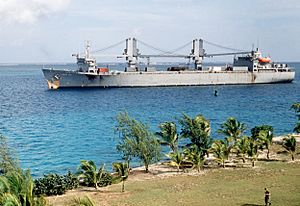
In 1970, Congress redefined the island's military mission as the storage and destruction of chemical weapons. The United States Army leased 41 acres (17 ha) on the Atoll to store chemical weapons held in Okinawa, Japan. Johnston Atoll became a chemical weapons storage site in 1971 holding about 6.6 percent of the U.S. military chemical weapon arsenal. The chemical weapons were brought from Okinawa under Operation Red Hat with the re-deployment of the 267th Chemical Company and consisted of rockets, mines, artillery projectiles, and bulk 1-ton containers filled with Sarin, Agent VX, vomiting agent, and blister agent such as mustard gas. Chemical weapons from West Germany and World War II era weapons from the Solomon Islands were also stored on the island after 1990. Chemical agents were stored in the high security Red Hat Storage Area (RHSA).
Some of the other weapons stored at the site were shipped from U.S. stockpiles in West Germany in 1990. These shipments followed a 1986 agreement between the U.S. and West Germany to move the munitions. Merchant ships carrying the munitions left Germany under Operation Golden Python and Operation Steel Box in October 1990 and arrived at Johnston Island November 6, 1990. Although the ships were unloaded within nine days, the unpacking and storing of munitions continued into 1991. The remainder of the chemical weapons was a small number of World War II era weapons shipped from the Solomon Islands.
Agent Orange storage 1972–1977
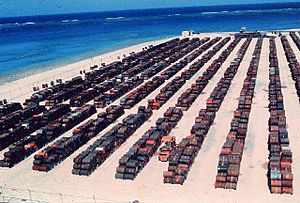
Agent Orange was brought to Johnston Atoll from South Vietnam and Gulfport, Mississippi in 1972 under Operation Pacer IVY and stored on the northwest corner of the island known as the Herbicide Orange Storage site but dubbed the "Agent Orange Yard". The Agent Orange was eventually destroyed during Operation Pacer HO on the Dutch incineration ship MT Vulcanus in the Summer of 1977. The U.S. Environmental Protection Agency (EPA) reported that 1,800,000 gallons of Herbicide Orange were stored at Johnston Island in the Pacific and that an additional 480,000 gallons stored at Gulfport, Mississippi was brought to Johnston Atoll for destruction. Leaking barrels during the storage and spills during re-drumming operations contaminated both the storage area and the lagoon with herbicide residue and its toxic contaminant.
Chemical weapon demilitarization mission 1990–2000
The Army's Johnston Atoll Chemical Agent Disposal System (JACADS) was the first full-scale chemical weapons disposal facility. Built to incinerate chemical munitions on the island, planning started in 1981, construction began in 1985, and was completed five years later. JACADS began operational verification testing (OVT) in June 1990. From 1990 until 1993, the Army conducted four planned periods of Operational Verification Testing (OVT). OVT was completed in March 1993, having demonstrated that the reverse assembly incineration technology was effective and that JACADS operations met all environmental parameters. The OVT process enabled the Army to gain critical insight into the factors that establish a safe and effective rate of destruction for all munitions and agent types.
All of the chemical weapons once stored on Johnston Island were demilitarized and the agents incinerated at JACADS with the process completing in 2000 followed by the destruction of legacy hazardous waste material associated with chemical weapon storage and cleanup. JACADS was demolished by 2003 and the island was stripped of its remaining infrastructure and environmentally remediated.
Closure and remaining structures
In 2003, structures and facilities, including those used in JACADS, were removed, and the runway was marked closed. The last flight out for official personnel was June 15, 2004. After this date, the base was completely deserted, with the only structures left standing being the Joint Operations Center (JOC) building at the east end of the runway, chemical bunkers in the weapon storage area and at least one Quonset hut.
Built in 1964, the JOC is a four-floor concrete and steel administration building for the island that has no windows and was built to withstand a category IV tropical cyclone as well as atmospheric nuclear tests. The building remains standing but was gutted entirely in 2004, during an asbestos abatement project. All doors of the JOC except one have been welded shut. The ground floor has a side building attached which served as a facility for decontamination that contained three long snaking corridors and 55 shower heads one could walk through during decontamination.
Rows of bunkers in the Red Hat Storage Area remain intact; however, an agreement was established between the U.S. Army and EPA Region IX on August 21, 2003, that the Munitions Demilitarization Building (MDB) at JACADS would be demolished and the bunkers in the RHSA used for disposal of construction rubble and debris. After placement of the debris inside the bunkers, they were secured and the entries blocked with a concrete block barrier (a.k.a. King Tut Block) to prevent access to the bunker interior.
Contamination and cleanup
Over the years, leaks of Agent Orange as well as chemical weapon leaks in the weapon storage area occurred where caustic chemicals such as sodium hydroxide were used during cleanup. Larger spills of nerve and mustard agent also took place. Small releases of chemical weapon components were cited by the EPA. Multiple studies of the Johnston Atoll environment and ecology have been conducted and the Atoll is likely the most studied island in the Pacific.
Contaminated structures were dismantled and isolated as a start for the cleanup program. About 45,000 tons of soil contaminated with radioactive isotopes was collected and placed into a fenced area on the north of the island. The area was known as the Radiological Control Area, but dubbed "The Pluto' Yard" because its heavy contamination with highly radioactive Plutonium. The Pluto yard is on the site of the LE1 emplactment where the 1962 missile explosion occurred and also where a highly contaminated loading ramp was buried that was made for loading plutonium contaminated debris onto small boats that was dumped at sea.
After closing
The atoll was placed up for auction via the U.S. General Services Administration (GSA) in 2005 before it was withdrawn. The stripped Johnston Island was briefly offered for sale with several deed restrictions in 2005 as a "residence or vacation getaway," with potential usage for "eco-tourism" by the GSA's Office of Real Property Utilization and Disposal. The proposed sale included the unique postal zip code 96558, formerly assigned to the Armed Forces in the Pacific. The proposed sale did not include running water, electricity, or activation of the closed runway. The details of the offering were outlined on GSA's website and in a newsletter of the Center for Land Use Interpretation as unusual real estate listing # 6384, Johnston Island.
On August 22, 2006, Johnston Island was struck by Hurricane Ioke. The eastern eye-wall passed directly over the atoll, with winds exceeding 100 mph (160 km/h). Twelve people were on the island when the hurricane struck, part of a crew sent to the island to deliver a USAF contractor who sampled groundwater contamination levels. All 12 survived and one wrote a first hand account taking shelter from the storm in the JOC building.
Since the base was closed, the atoll has been visited by many vessels crossing the Pacific, as the deserted atoll has a strong lure due to the activities once performed there. Visitors have blogged about stopping there during a trip, or have posted photos of their visits.
In 2010, a Fish and Wildlife survey team identified a swarm of Anoplolepis ants that had invaded the island. The crazy ants are particularly destructive to the native wildlife, and needed to be eradicated. The "Crazy Ant Strike Team" project was led by the U.S. Fish and Wildlife Service, who achieved a 99% reduction in ant numbers by 2013 and who continue to work towards a full eradication of the species from the atoll. The team camped in a bunker that was previously used as a fallout shelter and office.
Johnston Atoll has never had any indigenous inhabitants, although during the late part of the 20th century, there were averages of about 300 American military personnel and 1,000 civilian contractors present at any given time.
Images for kids
See also
 In Spanish: Atolón Johnston para niños
In Spanish: Atolón Johnston para niños




